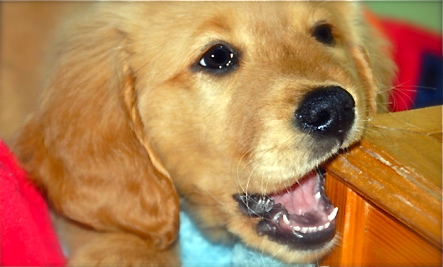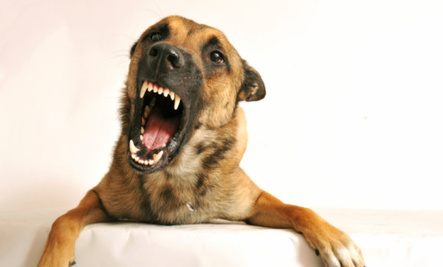1: Tooth Root Abscess
One of the more agonizing oral problems your dog may experience is a tooth root abscess. This occurs if the root of the tooth became exposed to bacteria — perhaps from a crack or break, or from advanced gum damage due to periodontal disease — and an infection has set in.
Signs that may indicate an abscess might be difficulty eating — your dog may be dropping food, tipping her head to one side or may avoid eating at all. As the abscess builds up, you may notice facial swelling. Depending on which tooth is affected, it may look like her eye is infected or inflammed, due to the proximity of the tooth’s roots to the eye.
A look inside your dog’s mouth should reveal the culprit — a bump, swelling or a localized area of the gums that looks red and angry. An abscess may spread to surrounding teeth, so it may be difficult to pinpoint which tooth is affected.
Due to the pain involved, it is wise to get your dog to the veterinarian quickly, who will do an X-ray to determine the extent of the problem. He may try to save the tooth with a root canal procedure, or he may need to extract it. He will probably also give your dog antibiotics to control the infection, and pain medication to help her feel better while she is awaiting the procedure and recovering.
2: Tooth Trauma
Keep an eye on what your dog chomps on. A hearty chew is great for his oral hygiene, but chewing the wrong object can leave him in dental distress. Rigid, solid objects can break or crack a tooth. A broken or cracked tooth can also result from an impact injury, tugging games or too-rough play.
A common type of broken tooth seen in dogs is called a slab fracture. This occurs if he forcibly bit down on a hard object, causing a section of tooth to flake off, ranging in size from a chip to a larger section.
With any type of cracked or broken tooth, the nerve of the tooth may become exposed, and that is painful. Sometimes, the nerve eventually dies, and his pain subsides. This is not the end of his problems, though, because the tooth may become infected, resulting in a return of pain and the introduction of bacteria.
You can help your dog avoid a broken tooth by monitoring what he chews on and never giving him solid, rock hard objects for chewing. Avoid brittle bones or hooves, or letting him gnaw on rocks, crate railings or solid posts. Chew toys should always be somewhat flexible, with some give to the surface, as a hard rubber or nylon material has.
Check with your vet if you see a cracked or broken tooth, even if your dog does not seem bothered by it. Treatment will depend on how badly the tooth has been damaged, which usually requires an X-ray to evaluate. Options include extraction of the tooth, root canal or a procedure called a vital pulpotomy, which is typically done in younger dogs if the tooth and root are otherwise in good health.
A broken tooth in a dog can be the gateway for a tooth root abscess, as mentioned at the beginning of this article.
3: Periodontal Disease
Your dog’s toys may carry a clue about her dental health. Does she leave spots of blood on them after she’s enjoyed a chew toy or vigorous playtime? Swollen, bleeding gums are a symptom of periodontal disease, the most commonly diagnosed oral problem in dogs.
Problems begin when plaque builds up on your dog’s teeth and transforms into a brownish substance, known as tartar. When this moves under the gum line, red, puffy gums develop, called gingivitis. Left untreated, this progresses into periodontal disease, causing the gums to recede and lose their function. This can eventually lead to tooth loss. Periodontal disease also introduces infection, which can travel in the bloodstream to affect other organs.
All dogs are susceptible to periodontal disease, but contributing factors include the reaction of the dog’s immune system, age, diet and chewing habits. In any dog, your best defense is routine dental care — a combination of at-home tooth brushing, good quality chews and periodic dental exams by a professional. Starting this at an early age will help your dog accept mouth handling more readily and will give her a head start on prevention.
If she is leaving tell tale spots of blood, has brown tartar on her teeth or if her gums look inflammed and sore, check with your vet. A professional tooth cleaning, done early, can remove the tartar and hinder the progression of gum disease.
4: Misaligned Teeth
Of course your dog is perfect in every way. But what about his teeth? Sometimes the adult teeth are crooked, or he may have a malocclusion — a misalignment of the upper and lower jaw. Some breeds are known for their trademark bite, but if it is extreme, your dog may have difficulty chewing.
With humans, an orthodontist will correct crooked teeth to improve a person’s smile or confidence. But in veterinary medicine, appearance is not a factor; standard protocol dictates correcting these issues only if they are causing an animal pain or preventing him from eating or drinking normally. This protects dogs (even show dogs) from undergoing dental procedures solely for aesthetic purposes.
If your dog’s bite seems to be causing him problems — perhaps a tooth is rubbing against the soft tissue, or eating seems to be a cumbersome, clumsy process — get him evaluated by a veterinary dentist. He would not give your dog braces, but he has ways to realign the teeth or may be able to provide relief by extracting or capping a problem tooth.
If the veterinarian determines that your dog’s oral condition is genetic, he may require that your dog also be spayed or neutered. This is another measure intended to protect dogs, to prevent future generations from experiencing the same discomfort.
Whether their teeth are crooked or straight, all dogs are at risk of periodontal disease.
5: Loose Teeth
For puppies, loose teeth aren’t a problem. Just like humans, their first set of teeth, called deciduous teeth, need to fall out to make room for their larger, permanent teeth. Between 4 and 6 months old, your pup will have frequent loose teeth. You may even find some cast-off ones in his bedding or around the house. By the time he’s about 7 or 8 months old, he should well on his way to sporting a new set of 42 adult teeth.
While all this activity is going on, periodically check inside your puppy’s mouth. Retained baby teeth are common — the deciduous tooth has not completely fallen out, but the adult tooth is coming in. If you see two teeth occupying one spot in your puppy’s mouth, check with your vet, who can help get the baby tooth out of the way. Otherwise, the adult tooth may come in crooked, possibly causing later problems.
For an adult dog, a loose tooth is more suspect. It usually results from trauma to the mouth or from gum loss due to advanced periodontal disease. It may also be a sign of illness.
Visit your vet if your adult dog has a loose tooth. She may do an X-ray to examine the tooth’s root or conduct an overall exam to screen for health issues. In almost all cases, a loose tooth would not correct itself, so your vet may suggest an extraction.





